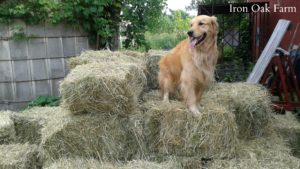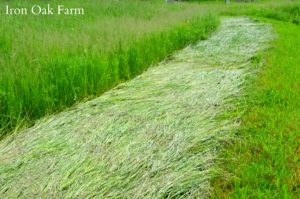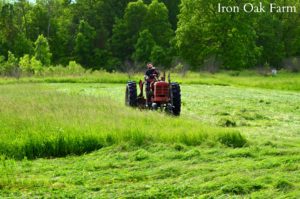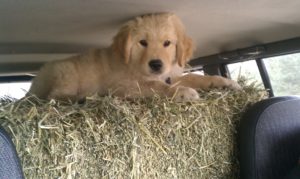Types of Hay and Determining Quality
 I wish there was better language to describe the type of hay that can be sold. “Hay” is often a very loose term for any vegetation that can be put through a baler. As anyone who’s ever been to a hay auction can attest, hay comes in many variations of quality.
I wish there was better language to describe the type of hay that can be sold. “Hay” is often a very loose term for any vegetation that can be put through a baler. As anyone who’s ever been to a hay auction can attest, hay comes in many variations of quality.
The more you know about quality hay, the better you can price your crop, or choose healthy feed for your animals.
Straw vs. Hay
 Just to clarify for those of you new to the world of agriculture, Hay and Straw are not the same thing. Straw is yellow in color, shiny and if looked closely, has a hollow shaft. Straw is not a food product, though animals may chew pieces of straw on occasion. Straw is the secondary product of grain production. It is the stalks of the grain stem after the seeds have been removed. Straw should only be used for bedding purposes.
Just to clarify for those of you new to the world of agriculture, Hay and Straw are not the same thing. Straw is yellow in color, shiny and if looked closely, has a hollow shaft. Straw is not a food product, though animals may chew pieces of straw on occasion. Straw is the secondary product of grain production. It is the stalks of the grain stem after the seeds have been removed. Straw should only be used for bedding purposes.
Alfalfa
Alfalfa hay is actually a legume and has a higher protein content. Alfalfa can often be a replacement for grain supplements in animals like goats. Alfalfa will have to be tilled up every few years, depending on the field, and replanted. Like an annual, the field should be allowed to rest between plantings, or rotated with other crops.
Grass Hay
 For the bulk of this article I will be dealing with grass hay. Good grass hay is usually a mix of grasses such as Timothy, Orchard, Bermuda and Bluegrass. It has a quality protein content (more about this below) and is visibly greenish in color, dense for the size of the bale, smells green and sweet and is free of mold and too many weeds.
For the bulk of this article I will be dealing with grass hay. Good grass hay is usually a mix of grasses such as Timothy, Orchard, Bermuda and Bluegrass. It has a quality protein content (more about this below) and is visibly greenish in color, dense for the size of the bale, smells green and sweet and is free of mold and too many weeds.
Once you have a quality grass hay field, just like a lawn, it will continue to produce hay for many years to come without much upkeep.
Protein Levels
A good grass hay should have a protein range between 10-14%. Alfalfa should be around 12-18%. You can contact your local county extension and have your hay analyzed for nutritional content.
 Our field is composed of wild grasses. There’s a lot of Timothy but a fair amount of weeds. Our protein levels are around 8-10% which is on the low side, but still acceptable for our goats who are supplemented with grain and alfalfa. Our plan is to till sections of the field each year and plant a hay seed mix to up the quality of our hay.
Our field is composed of wild grasses. There’s a lot of Timothy but a fair amount of weeds. Our protein levels are around 8-10% which is on the low side, but still acceptable for our goats who are supplemented with grain and alfalfa. Our plan is to till sections of the field each year and plant a hay seed mix to up the quality of our hay.
We don’t sell hay, but as it is now, our hay would not bring a good price at auction, especially for horse owners. Ruminants like cows and goats are able to tolerate a lower protein hay than horses.
When to Cut
Many factor effect the quality of hay. Along with the clear weather windows that we discussed in Part 1 of this series, knowing when the hay crop is ready is also important.
When in doubt, cut early and short. To get quality hay you have to understand how a plant works and where the nutrition is stored.
As a blade of grass grows it stores energy within itself to eventually produce seed. Seed production furthers the species and ensures the survival of grass. If your hay field goes to seed before you cut, all that food energy will have been used by the plant to make the grass seed and not made available to your animals.
First Cutting, Second Cutting Etc.
 First Cutting is just as it sounds, it is the first harvest of the hay field that season. Second Cutting and any subsequent cuttings will also play a role in describing your hay quality.
First Cutting is just as it sounds, it is the first harvest of the hay field that season. Second Cutting and any subsequent cuttings will also play a role in describing your hay quality.
As a rule of thumb, 1st cutting will bring the lowest price and lowest quality at auction. The reason correlates to the above mention of seed production. As grass grows it strives to begin seed production. After the hay is cut the first time, seed production is halted. The continued growth of grass is more uniform and nutritious. Subsequent cuttings can be of similar quality so long as the hay isn’t entering winter dormancy.
Hay Condition
Look for signs of poor hay:
-Hay that is moldy from improper storage or was baled too soon.
-Sun bleached hay, over dry hay, hay that sat in the filed too long before baling.
-Brown hay, usually this is caused from the cut hay being rained on before bailing. The rain will leach out the nutrition and the color.
Be sure to check out the other posts in this series:
A Guide to Buying and Selling Hay Part 1: Making Hay and Buying Equipment
A Guide to Buying and Selling Hay Part 3: Proper Storage of Hay and Pricing










